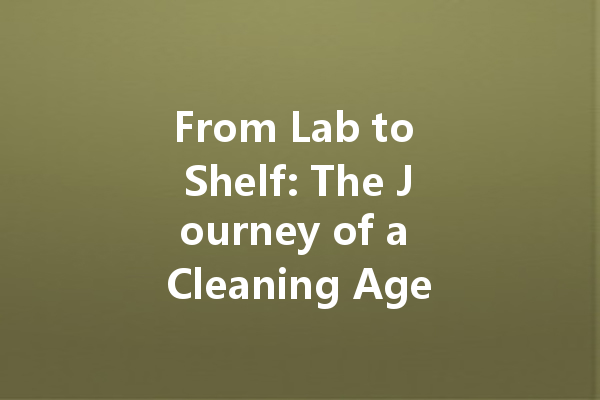Cleaning agents play a crucial role in maintaining hygiene, cleanliness, and safety in both residential and commercial environments. But have you ever wondered how these products transition from the lab to store shelves? This article will explore the intricate journey of a cleaning agent, detailing the stages involved in its creation, testing, and eventual distribution.
The Formulation Process
The journey of a cleaning agent begins in the laboratory where chemists and product developers work diligently to create a formula that is both effective and safe. This phase involves selecting ingredients based on their cleaning power, safety profiles, and compatibility with consumer preferences.
Ingredients Selection
Choosing the right ingredients is vital. Raw materials such as surfactants, solvents, and fragrances must be combined in a way that maximizes cleaning efficacy while minimizing potential hazards. In many cases, manufacturers are also seeking eco-friendly ingredients to meet growing consumer demands for sustainable products. The trend towards biodegradable or plant-based components is becoming increasingly common.
Testing and Adjustments
Once a formula is created, it must undergo rigorous testing. This phase often includes stability tests, where the product is assessed for how well it holds up over time under various conditions. For instance, will the effectiveness of the cleaning agent diminish after a few months? Lab testers simulate transport, exposure to temperature variations, and even spritzing on different surfaces to ensure the formula remains effective.
規制遵守
After formulation and initial testing, the next major hurdle is regulatory compliance. Cleaning agents are subject to various regulations set by governmental bodies such as the Environmental Protection Agency (EPA) in the U.S. Manufacturers must provide detailed information about their ingredients and conduct safety assessments to ensure their products do not pose a risk to consumers or the environment.
Safety Data Sheets
To comply with regulations, thorough documentation, including Safety Data Sheets (SDS), must be created. These sheets provide crucial information regarding the product’s composition, potential hazards, and safe handling instructions.
Regulatory Approvals
This phase can be time-consuming, as it may involve submitting samples to regulatory agencies for approval. The timeline can vary significantly depending on the region or country. Some countries have stricter regulations than others, which can impact where the product is eventually sold.
Packaging Development
Once regulatory approvals are in place, the next step is developing the packaging. The housing of a cleaning agent is not merely for aesthetics; it must be functional, durable, and safe. Packaging also plays a pivotal role in marketing, as visually appealing containers attract consumers.
Design Considerations
During the packaging development phase, several factors are taken into consideration, including material choice, ease of use, and eco-friendliness. For instance, companies may opt for recyclable materials or even emphasize refillable designs to reduce overall waste.

Labeling and Branding
Effective labeling is crucial as it provides essential information to consumers. Labels must prominently display product information, usage instructions, and safety warnings. In today’s market, branding also takes precedence, and manufacturers invest in creating compelling brand identities that resonate with their target audience.
Distribution and Marketing
With the product formulated, tested, packaged, and labeled, it is now time to enter the distribution phase. This stage involves getting the cleaning agent from the manufacturing facility to retail stores or directly to consumers.
Supply Chain Management
Effective supply chain management is essential for ensuring that products are distributed efficiently. Manufacturers often partner with logistics companies to navigate shipping considerations, inventory management, and transportation costs. Efficient handling at this stage ensures that products are readily available to meet consumer demand.
Marketing Strategies
Simultaneously, marketing strategies are developed to promote the new cleaning agent. Successful campaigns might include advertisement via social media, collaborations with influencers, or traditional marketing channels such as TV and print advertisements. The goal is to convey the product’s benefits and distinguish it from competitors.
Consumer Feedback and Adaptation
Once the cleaning agent hits store shelves, the journey is far from over. Customer feedback plays an invaluable role in refining and improving the product.
Gathering Reviews
Manufacturers actively seek consumer reviews and feedback to understand how their products are received. Surveys, online reviews, and social media interactions help brands gauge customer satisfaction and identify areas for improvement.
Iterating the Product
If consistent issues or suggestions arise, manufacturers may revisit the formula and occasionally adjust the formulation accordingly. This dynamic approach ensures that the product remains competitive and meets the ever-evolving needs of consumers.
結論
The journey of a cleaning agent from lab to shelf involves meticulous planning at every step. From the careful selection of ingredients to the rigorous testing and compliance processes, manufacturers prioritize safety and effectiveness. With the added focus on marketing and consumer feedback, the evolution of cleaning agents is a collaborative effort between manufacturers and their consumers, ultimately leading to クリーナー, safer environments. This comprehensive approach not only reinforces the importance of cleaning agents but also highlights the industry’s commitment to innovation and sustainability in everyday cleaning solutions.
